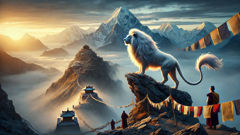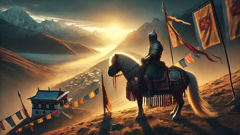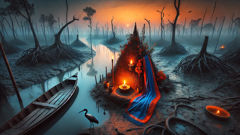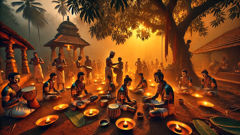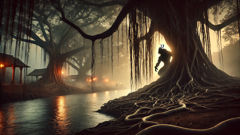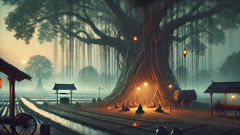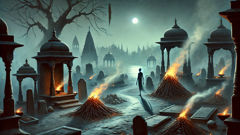Introduction
Beyond the needle-blue line of the lower valleys, where barley terraces clutch the earth and prayer flags stitch bright knots into wind, the land changes its voice. Here, the air thins into a cold clarity that makes every breath an offering; here, clouds become rivers of white and the peaks keep secrets older than speech. The Snow Lion is born in that thin place between sky and stone — not of flesh alone but of the mountain's memory. In villagers’ tales, in the scratch of a painter's brush on a monastery wall, and in the quiet, ceremonial stomp of a dancer in festival white, the Snow Lion walks. It is a creature of paradox: fierce yet cheerful, solitary yet present at the threshold of every hearth and shrine. This myth is a map — not of roads but of meaning. It charts how people of the high plateaus learn courage from the wind, how cheerfulness can be an act of resistance against cold and scarcity, and how a symbol carved in bone or woven into fabric can hold a nation’s spine. Read on and you will find the Snow Lion's first steps, its meetings with mortals and monks, the ways its image came to wave from banners and flags, and how one small herder learned that fearlessness is sometimes a quiet, daily ritual rather than a single heroic roar.
The Birth of the Snow Lion
The oldest stories the elders tell do not begin with a single name; they begin with elements. Wind—sharp and ancient—rushed down from the central ridge of the world and scooped up the lightest of snows, carrying them like handfuls of silver across the plateaus. The sky, wide and witness to everything, lent its pale clarity. Between stone and sky, in a crevice warm with the memory of a sun that does not always stay, the first Snow Lion shook itself free of weather and wonder.
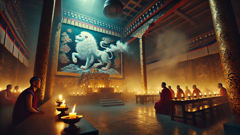
People of those early settlements spoke of the birth not as a biological event but as a confluence. A monk returning from a night-long vigil at the cliff-side shrine saw the hairline of a creature moving through a drift as if it were a part of the blowing sky. A shepherd boy, who had lost his only goat to a ravenous snowstorm and had vowed never to speak again, found his breath returned not by a potion but by the lion’s passing. The Snow Lion did not arrive carrying dominion; it carried invitation. Invitation to be brave in the face of a relentless cold, to find cheer in a place where hearty laughter is scarce. In the telling, the lion's mane shimmered with patterns like the milky swirls of glacier crevasses and its pawprints left tiny blossoms of blue frost that glowed in moonlight and faded at dawn.
The Snow Lion's first encounter with humans shaped the myth into the moral scaffold that would hold generations. The monks at the nearest gompa first recorded the creature in thangka paintings: a leonine body of pure white, a mane like clouds, eyes like polished lapis. In those paintings the lion stands upon a mountain, one paw raised not in menace but in greeting. In time the monks gave the lion attributes—fearlessness, cheerfulness, and the ability to clear spiritual obstacles—making it a mirror for the aspirant's own inner journey. Yet the earliest villagers that met the Snow Lion cherished different, more earthly lessons. A mother whose children were starved came out to the slope and found a ribbon of thawed ground where the Snow Lion had slept; crops sprouted there sooner than anywhere else. An old metalworker, bent as an iron bell, found his hammer true again after a night in which he swore the lion had tapped the anvil with a paw.
Across seasons, the Snow Lion proved to be an agent of paradox. It was solitary, yet it attended festivals. It would not be ridden or tamed, but its likeness adorned every child's sash and every household shrine. Children chased the echo of its footfalls, leaning out of high window frames and imagining that cheer was a thing to be summoned like a dog. Pilgrims coming down from remote caves where they meditated for months would report visions in which the lion’s laugh had opened a mind-block they could not explain. Traders crossing high passes carved the lion into amulets for good fortune; brides embroidered it into ceremonial scarves as a blessing for the groom’s courage. From the first breath of snow to the last ember in a winter hearth, the Snow Lion’s presence embroidered the social cloth.
This myth also braided itself into the land's rituals. At harvests, the eldest would lead a small procession along the ridge where the lion was said to roam, scattering a little flour and barley in its footprints as both thanks and request. Monks held dances where performers wore wolf-white costumes with exaggerated manes, leaping and laughing in mock ferocity, reminding everyone that courage need not be stern; it could be bright and buoyant. On days of remembrance, communities lit tall candles and placed painted images of the Snow Lion on household altars to invite both protection and a resilient joy: to remember that sorrow and celebration are weather patterns that pass over the highlands, and it is the steady heart that endures.
Even when strangers passed through—merchants, geographers, and later, officials from distant courts—they recorded the image of the lion with bewildered respect. Where some outsiders saw superstition, those who stayed longer observed a subtler truth: the Snow Lion's myth was a social technology. It taught people to face avalanches of misfortune with a mix of courage and laughter. It gave names to resilience, and names make things easier to carry. In art, the lion’s white became a canvas for color: cerulean eyes, mane fringed with turquoise and saffron ribbons, a tongue like crimson paper. The image grew and adapted like any living tradition, taking on local motifs—bone jewelry of nomads, braided tassels from valley towns, and architectural cornices in monastery eaves.
But myths do not remain flattering. The Snow Lion’s image, once a private spiritual aide, was sometimes enlisted by human politics. Leaders and warlords would raise banners with the lion to claim righteous rule, arguing that fearlessness granted by the lion validated conquests. Monks argued back: symbols cannot bless every act; they hold the intent of those who bear them. These tensions became part of the lion's story too—teaching that the sanctity of a symbol depends on the heart that carries it. As the narratives spread beyond the plateaus, the Snow Lion entered wider Himalayan lore, braided with tales of dragons and mountain spirits. In every telling the creature kept its essential lesson: to face hardship with an open chest and a light heart is itself an act of defiance and devotion.
Thus was the Snow Lion born into both the wind and the people's hearts. It became at once an emblem of spiritual threshold and an everyday friend, a myth to be sung by wandering bards and a quiet companion to the ones who put their lives on the line to grow barley on thin soil. The lion's first pawprints, the elders said with a smile, were as much on the snow as on the memory of the world.
The Journey of the Herder and the Snow Lion
There is one story that villagers tell with particular tenderness: the story of Tenzin, the young herder who learned the lion's lesson at the cost of much fear and a small, improbable kindness. Tenzin was not a monk and not of noble blood. He shepherded a modest fold of yaks and goats across a ridge where the weather could change like a mood. His hands were cracked from cold and rope; his voice could coax a goat from a ledge but could not calm his sister when she cried for the father she had not seen since the war. Tenzin's courage, if it existed, was the kind forged in habit: he rose before the light and fell asleep after the stars. He had no formal instruction in the ways of myth and spirit, but myths have their own methods; they find the ones with unpretentious need.
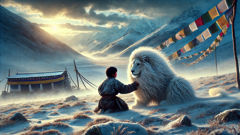
The encounter began on a day when the sky felt like a promise and then turned to a test. A storm rose fast, like a curtain thrown across the mountain. Snow blew into knives and the path home disappeared. One by one, goats strayed and fears multiplied into voices that spoke of frostbite and loss. Tenzin lost the path and then his footing, tumbling into a shallow drift. In the hollow where he landed, the wind seemed to pause, as if listening. He began to sing, not because he believed it could change the weather but because singing had always been what he did when silence felt too dangerous. The song was a small thing: a tune his mother hummed to warm milk, a rhythm that named his village. In the chorus of storm and fear a sound came back—soft at first, then clearer—a deep rumbling that matched his heartbeat.
When the snow settled and the light returned, Tenzin found before him a living blur: white and huge and not threatening. The Snow Lion stood with powder on its whiskers, breath steaming in the silver air. People who tell the tale argue about what happened next. Some say the lion licked the wind with a tongue of frost that tasted of barley and river. Others say it roared in a way that hummed through a man’s bones and rearranged his courage like a garment. The version Tenzin told later, when he grew older and his voice learned the softness of memory, was simpler: the lion nudged him, the way a friend nudges another out of stubbornness. It pushed against his shoulder and then lay down in a shape that blocked the wind. If there was a lesson, he said, it was that bravery had a gentleness to it. Courage does not always shout; sometimes it is a body that shields and a presence that makes cold less heavy.
After that night, Tenzin's life did not become a parade of miracles. He still mended fences, still milked the yaks, still argued with market traders over salt and tea. But small changes arrived like garnishing on staple foods. He spoke less to imagine his losses and more to stitch stories into the next generation. He repaired old snowbound roofs where his neighbors were too proud to ask for help. Children gathered around him on winter evenings because the warmth of his storytelling was real and contagious. He began to wear a small pendant carved with the lion's likeness, not as mark of power but as a constant reminder: that fearlessness could be practiced in modest acts, like walking home to fix a roof after a storm.
The tale of Tenzin and the Snow Lion spread, and with it a set of practical rituals. Shepherds tied blue ribbons to poles at the edge of the pasture and told travelers that the ribbons were a memory of the lion’s white mane. Women hung embroidered lions in baby cradles, less to ward off monsters than to teach infants a language of cheer. During times of famine, communities staged 'lion-roams'—teams of volunteers who would go to the nearest villages and break ice on wells, check on elders, and feed animals that could not find forage. The practice had no formal name in any law book; it existed because people remembered Tenzin's small act of care and named it courage. This was the Snow Lion's hardest lesson: that myth must move into behavior if it is to continue to mean anything.
Religious practitioners and artisans took Tenzin's story and steeped it in layers of symbolism. A lama painted the lion with eyes that look beyond time, linking the creature to the bodhisattva ideal—compassion as courage, fearlessness as a form of loving. A weaver made a thangka in which the Snow Lion danced around a mandala, indicating that cheerfulness was integral to the path of realization. Over generations the iconography leaned canonical: the Snow Lion's raised paw represented the breaking of obstacles, its open mouth stood for the proclamation of truth, and its playful expression reminded the faithful that enlightenment need not be austere. In monasteries the lion became a companion to protector deities, and in outlying hamlets it remained a friend to the child who feared the dark.
When outside forces and political upheavals swept across the highlands, the Snow Lion endured as a cultural anchor. In times of suppression and exile, images of the lion gathered meaning similar to a lighthouse. It was used by some political movements to evoke a past that people recognized and a courage they needed; by others it was reclaimed as a symbol of cultural survival, stitched into prayer flags carried across borders and into the memories of diaspora communities. The debate over usages mirrored the early tension between those who used the lion for conquest and those who insisted on its inner, moral instruction. The lion itself, if one might say it had a will across centuries, remained indifferent to flag and mandate; it persisted through weather and story, through the small kindnesses exemplified by Tenzin and others.
In one late telling, a pilgrim far from the plateau described how images of the Snow Lion hung in an exile's tent like a fragment of home. When that tent caught the first real winter in a new land and the elderly felt the old cold sharpen their bones, a group of children reenacted the lion-roam ritual. They broke ice for a neighbor, knitted blankets for elders, and held a feast where they danced and laughed. The act knitted generations together and proved the lion's lesson: that fearlessness is taught not solely by grand acts but by a culture that practices cheerfulness in the face of hard weather. The Snow Lion, in these stories, becomes less an untouchable guardian and more a method—a template for how to live in a world of wind and scarce warmth. For people who knew snow intimately, the greatest bravery was to stay kind when everything suggested otherwise.
By the time artists and chroniclers across the region began depicting the Snow Lion on banners and flags, it had accumulated so many meanings that each depiction felt like a focused beam from a lantern revealing one facet of the whole. To some it was a martial emblem; to others, a devotional icon. To most, it remained a friend—a white mane against evening sky, an old story that taught the living how to be alive: brave, buoyant, and steady on the path.
Conclusion
Symbols travel farther than the people who first draw them. The Snow Lion began as an answer to cold and fear at the height of the world and grew into something that could be sewn into banners, painted on temple walls, and worn next to the heart. It taught that courage can be buoyant, that cheerfulness is a form of resistance, and that compassion and fearlessness often arrive together. The lion's image on flags and in rituals was not merely ornament but a living instruction: face hardship with an open chest and a smile wide enough to welcome help. When you read the myth today, whether you stand on the high plateaus or in a city thousands of miles away, you carry both a story and a practice. The Snow Lion offers a ritual of return: in the small, repeated acts of care—mending a roof, breaking ice, telling a story—you practice fearlessness until it becomes ordinary. It is a myth that refuses to stay only on canvas; it insists on being walked into the world, one careful, cheerful step at a time.

